Instrumentation and Process Control
PLC Programming
-
Question 1
In this machine center, all real-world inputs are N.O. proximity sensors arranged along a conveyor line.
Describe all combinations of inputs that would allow the output to energize.
 Reveal answer
Reveal answerThis is a simple answer: the input must be energized (in other words, an object is detected in front of the sensor) for the output to become energized.
Notes:In all exercises, the sensors are assumed to be either inductive, capacitive, or light-on optical proximity switches, with either NPN or PNP wiring. Each problem will specify whether they are normally open (N.O.) or normally closed (N.C.) contacts.
Remember this important difference between logic and circuits. Any real-world device, whether N.O. or N.C. can be programmed in the PLC to energize an output. Do not worry about whether the real-world device is N.C. or N.O., but rather, try to identify the conditions that will allow current to flow through the device or not, which will influence its behavior in the logic.
To review the differences between normally open and closed, check out our educational article before proceeding.
Reference educational articles:
-
Question 2
In this machine center, all real-world inputs are N.C. proximity sensors arranged along a conveyor line.
Describe all combinations of inputs that would allow the output to energize.
 Reveal answer
Reveal answerThe input must be de-energized (no object detected; the area in front of the sensor is clear) for the output to become energized.
Notes:Reference article: normally open vs. normally closed contacts
Other reference educational links:
-
Question 3
In this machine center, all real-world inputs are N.O. proximity sensors arranged along a conveyor line.
Describe all combinations of inputs that would allow the output to energize.
 Reveal answer
Reveal answerThe input must be de-energized (no object detected) for the output to become energized.
Notes:Reference article: normally open vs. normally closed contacts
Other reference educational links:
-
Question 4
In this machine center, all real-world inputs are N.C. proximity sensors arranged along a conveyor line.
Describe all combinations of inputs that would allow the output to energize.
 Reveal answer
Reveal answerThe input must be energized (detecting an object) for the output to become energized.
Notes:Reference article: normally open vs. normally closed contacts
Other reference educational links:
-
Question 5
In this machine center, all real-world inputs are N.O. proximity sensors arranged along a conveyor line.
Describe all combinations of inputs that would allow the output to energize.
 Reveal answer
Reveal answerRemember: These are normally open devices!
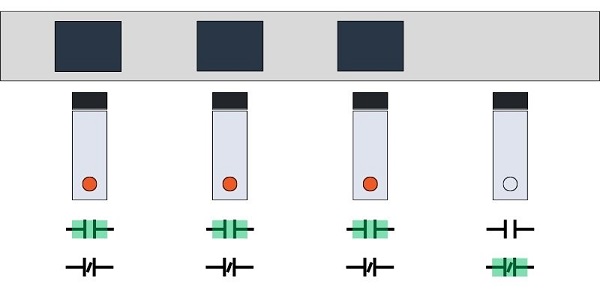
Inputs 1-3 must be energized (detecting an object), and input 4 must be de-energized (no object detected) in order for the output to energize.
Notes:Reference article: normally open vs. normally closed contacts
Other reference educational links:
-
Question 6
In this machine center, all real-world inputs are N.C. proximity sensors arranged along a conveyor line.
Describe all combinations of inputs that would allow the output to energize.
 Reveal answer
Reveal answerRemember: These are normally closed devices!
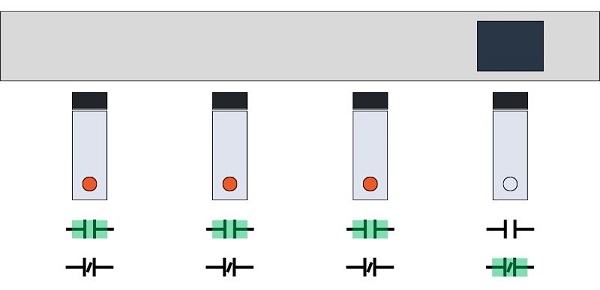
Inputs 1-3 must be de-energized (no object detected), and input 4 must be energized (detecting an object) in order for the output to energize.
Notes:Reference article: normally open vs. normally closed contacts
Other reference educational links:
-
Question 7
In this machine center, all real-world inputs are N.O. proximity sensors arranged along a conveyor line.
Describe all combinations of inputs that would allow the output to energize.
 Reveal answer
Reveal answerRemember: These are normally open devices!
Two possible combinations allow the output to be energized:
Inputs 1 and 3 must be energized (detecting an object), while inputs 2 and 4 could be in either state.
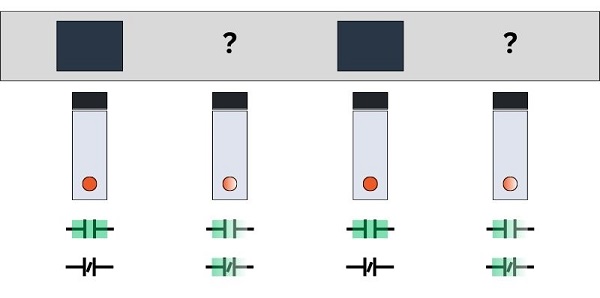
OR
Inputs 2 and 4 must be de-energized (no object detected), while inputs 1 and 3 could be in either state.
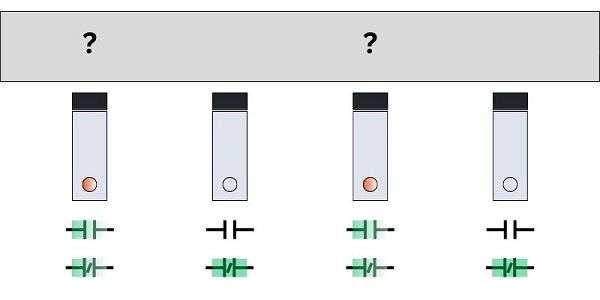 Notes:
Notes:Reference article: normally open vs. normally closed contacts
Other reference educational links:
-
Question 8
In this machine center, all real-world inputs are N.C. proximity sensors arranged along a conveyor line.
Describe all combinations of inputs that would allow the output to energize.
 Reveal answer
Reveal answerRemember: These are normally closed devices!
Two possible combinations allow the output to be energized:
Inputs 1 and 3 must be de-energized (no object detected), while inputs 2 and 4 could be in either state.
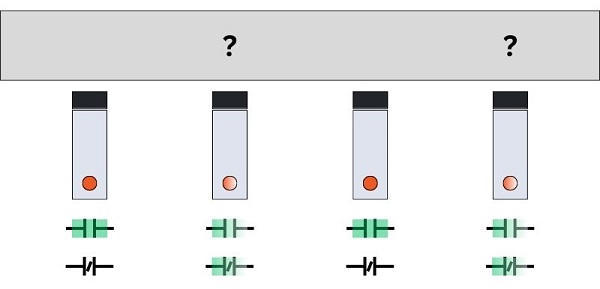
OR
Inputs 2 and 4 must be energized (detecting an object), while inputs 1 and 3 could be in either state.
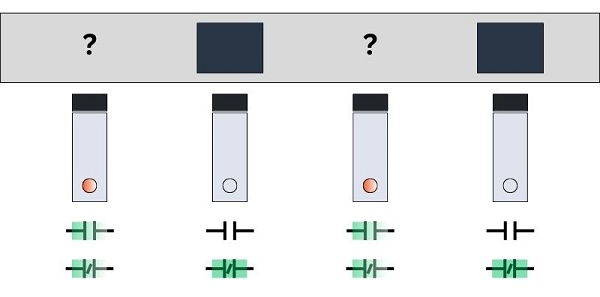 Notes:
Notes:Reference article: normally open vs. normally closed contacts
Other reference educational links:
-
Question 9
In this machine center, all real-world inputs are N.O. proximity sensors arranged along a conveyor line.
Describe all combinations of inputs that would allow the output to energize.
 Reveal answer
Reveal answerRemember: These are normally Open devices!
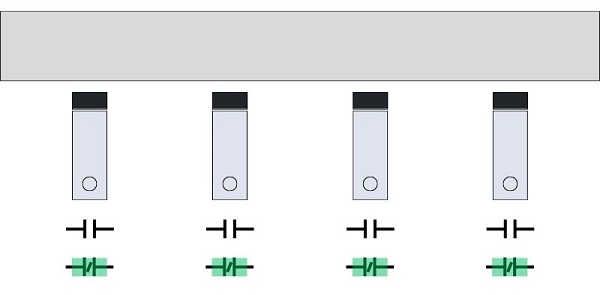
All inputs must be de-energized (no object detected) in order for the output to energize.
Notes:Reference article: normally open vs. normally closed contacts
Other reference educational links:
-
Question 10
In this machine center, all real-world inputs are N.C. proximity sensors arranged along a conveyor line.
Describe all combinations of inputs that would allow the output to energize.
 Reveal answer
Reveal answerRemember: These are normally Closed devices!
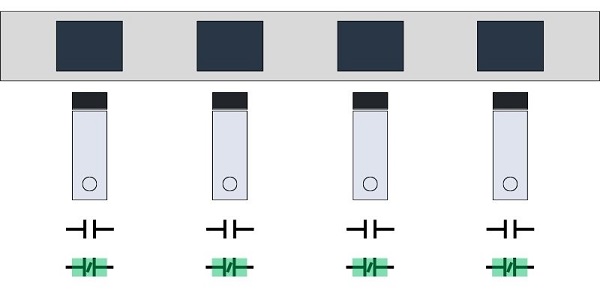
All inputs must be energized (detecting an object) in order for the output to energize.
Notes:Reference article: normally open vs. normally closed contacts
Other reference educational links:
-
Question 11
A series of real-world N.C. emergency stop (E-Stop) devices must keep an output motor contactor energized unless any one of the buttons is pressed.
If these N.C. E-stop buttons are connected to a safety PLC input module, how should the ladder logic rung be designed to keep the output energized until any button is pressed?
Reveal answer
Remember: N.O. contacts will energize only when electricity is flowing into the input.
When a normally closed button is un-pressed, electricity is flowing.
In this way, the PLC is ‘tricked’ into thinking we have standard N.O. pushbuttons that are being pressed.
‘Tricking’ is, perhaps, the wrong way to explain the situation since the programming is quite reliable, but this problem illustrates why we must think of the PLC logic in terms of the electrical continuity of the real-world devices.
Notes:Reference article: normally open vs. normally closed contacts
Other reference educational links:
-
Question 12
In this machine center, all real-world inputs are N.O. proximity sensors arranged along a conveyor line.
Describe all combinations of inputs that would allow the output to energize.
 Reveal answer
Reveal answerRemember: These are normally Open devices!
Two possible combinations allow the output to be energized:
In both cases. Input 1 must be energized (detecting an object) and input 4 must be de-energized (no object detected).
Beyond this, input 2 must be de-energized (no object detected), and input 3 does not matter.
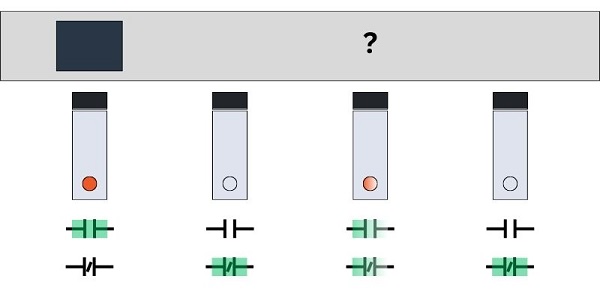
OR
Input 3 must be energized (detecting an object), and this time, input 2 does not matter.
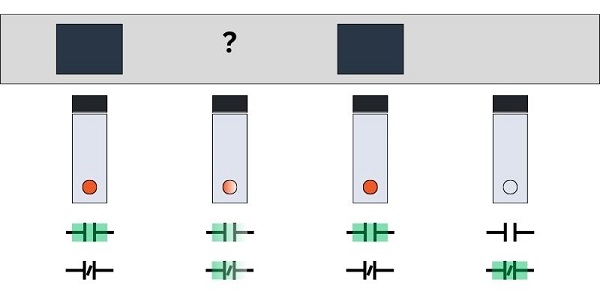 Notes:
Notes:Reference article: normally open vs. normally closed contacts
Other reference educational links:
-
Question 13
In this machine center, all real-world inputs are N.C. proximity sensors arranged along a conveyor line.
Describe all combinations of inputs that would allow the output to energize.
 Reveal answer
Reveal answerRemember: These are normally Open devices!
Two possible combinations allow the output to be energized:
In both cases. Input 1 must be de-energized (no object detected) and input 4 must be energized (detecting an object).
Beyond this, input 2 must be energized (detecting an object), and input 3 does not matter.
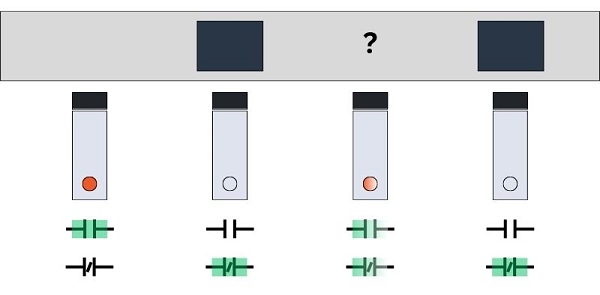
OR
Input 3 must be de-energized (no object detected), and this time, input 2 does not matter.
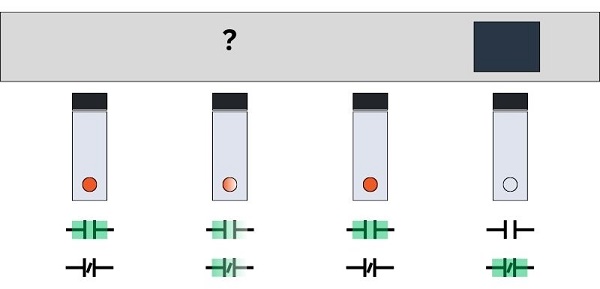 Notes:
Notes:Reference article: normally open vs. normally closed contacts
Other reference educational links:

 Facebook
Facebook Google
Google GitHub
GitHub Linkedin
Linkedin
